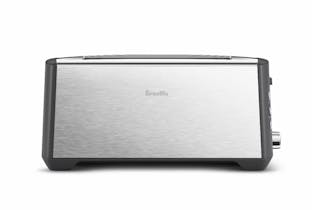Toasters
Find the best toaster for your home with our buying guide and test results for 53 new and 8 discontinued models.
Two-slice or four-slice? Find out what to look for in a toaster, then check out our test results to see which models will guarantee you perfect toast every time.
Best toasters of 2025
-

Top-performing 4-slice toasters
-

Top-performing 2-slice toasters
-

Most stylish toasters
-

The toaster we'd avoid

Get access to Consumer & see all reviews
✔ Personal support through our Consumer Rights Advice Line
✔ Premium articles and in-depth buying advice
✔ Add a Consumer magazine for even more exclusive content
Two-slice or four-slice?
Four-slice toasters are great if you have a big household or a big appetite. They usually have separate levers for each pair of slots, and some also have separate browning controls for each pair. There are also 4 slice toasters that only have 2 ‘long’ slots so are not as wide as a 4 slot model, you just toast 2 slices next to each other in the single slot.
Two-slice toasters take up less space, and often have wider and longer chambers so you can toast a wider variety of shapes and sizes – handy if you eschew “standard” loaves in favour of artisan breads.
Ease of use
A toaster’s crumb tray should be simple to remove and replace, and controls should be well labelled and easy to operate. Some toasters have separate controls for each slot, which is brilliant for toasting different breads at the same time when one needs a longer blast.
While it might not look as sophisticated, a plastic shell is usually easier to clean than one made of stainless steel. Look for a toaster with a smooth shell and not too many ‘nooks and crannies’ for crumbs to get trapped in.
Features to look for
Aside from safety improvements, high-end toasters tend to pack in features that are nice to have, but not usually essential. They could improve your toasting experience, but you might be just as happy with a cheap, simple model.
- If you keep bread in the freezer, a defrost/frozen setting adds a little time to the cycle so the bread thaws properly.
- A reheat setting comes into play when you get your kitchen timing wrong. You can, however, get the same effect by turning the browning control right down.
- A “lift and look” or “quick check” feature that raises the carriage so you can see how close your toast is to perfection.
- An LED progress indicator counts down the seconds.
- Instead of popping up abruptly, a motorised lift gently raises the toast when it’s done.
- An audible alert lets you know when your toast is toasted.
- A high-lift carriage allows you to raise smaller items, such as crumpets, above the toaster slots.
- A crumpet or bagel setting that heats the inner face more than the outer.
Price vs performance
The price of a toaster is not necessarily indicative of its ability to toast well. Many of the more expensive and aesthetically pleasing models will not toast as well as the cheaper models. Before you buy, check our reviews to see if the model you have your eye on is actually going to perform.
Which toasters are most reliable?
We ask thousands of Consumer members about their products to find out which brands are most reliable and satisfying to own. The results are available to members and Digital Pass holders.

People's Choice
Our People's Choice awards are granted to brands that consistently rate above average for customer satisfaction and meet out other performance criteria. Become a member and see which brands have earned a People’s Choice award.
We've tested 61 toasters.
Find the right one for you.
Braun
.jpg&w=315&q=75)
Breville
.jpg&w=315&q=75)
Breville
